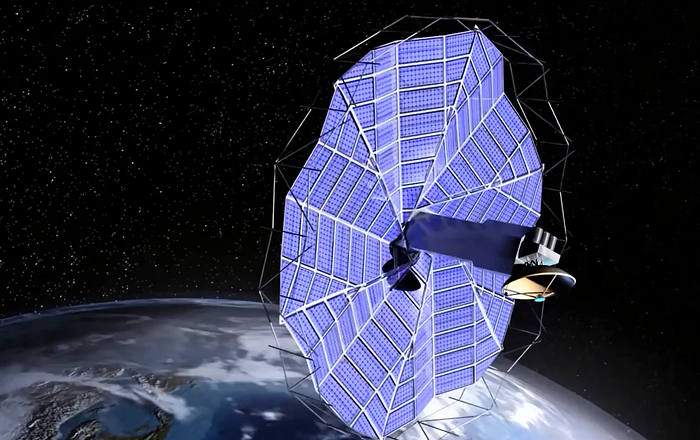MODeL-T explores origami-inspired foldable flat optics for compact lidar missions

An artist’s rendition of an origami-inspired solar panel mid-deployment. Stowed lidar antennas could dramatically reduce the size and expense of space-based lidar instruments. Image credit: Ux Connections
02/10/25 – A team of researchers at NASA’s Goddard Space Flight Center (GSFC) are taking cues from the ancient Japanese art of paper folding to develop a compact deployable telescope, which could dramatically reduce the cost of sending lidar missions into space.
The “Metalens Origami Deployable Lidar Telescope (MODeL-T),” developed with support from NASA’s Earth Science Technology Office (ESTO), would be a composite lens made of more than 50 segments that fold together to form a compact cube. In space, that compact cube would unfold into a flat, star-shaped structure nearly two meters wide, tailored to direct captured lidar signals towards a receiver. Compact at launch and large in space, MODeL-T could allow small space craft to host lidar instruments as powerful as those found on larger, more expensive platforms.
Compact lidar systems equipped with MODeL-T would fit aboard ESPA-class satellites, allowing scientists to take advantage of cost-efficient rideshare launch opportunities. Compared to previous missions, lidar equipped with MODeL-T could reduce the cost of space-based lidar by as much as a factor of 20.
“It’s like moving from launching a large refrigerator into orbit to launching a suitcase,” said Mark Stephen, a Research Engineer at GSFC and Principal Investigator for MODeL-T.
Stephen, who helped develop the lidar instruments for ICESat and ICESat-2, explained that MODeL-T would replace the large receiver telescopes traditional lidar instruments rely on to capture photons and guide them towards a detector, which are essentially empty tubes with large beryllium optics.
MODeL-T would be smaller than these traditional telescopes at launch, but larger once deployed. Whereas the telescope aboard ICESat-2 has an aperture one meter wide and takes up 400 liters of stowed space, MODeL-T would have an aperture 1.8 meters wide and take up just 100 liters of stowed space.
Larger apertures mean more photons reach a lidar detector, which improves data resolution and lowers the power requirements for lidar transmitters. If more return photons are captured per laser pulse, a lidar instrument can employ a smaller, lighter laser without sacrificing an effective signal-to-noise ratio.
To develop MODeL-T, Stephen’s team overcame two significant technology hurdles: first, finding a flat, foldable material that manipulates light with the same reliability as traditional bulk optics; second, creating a lightweight mechanism for unfolding that flat material once in space.
Xingjie Ni, Associate Professor of Electrical Engineering at Pennsylvania State University, led the development of the foldable metamaterial optic, while Larry Howell, Associate Academic Vice President and Professor at Brigham Young University, led the development of the deployment mechanism.
Metamaterials use complex arrays of sub-micrometer-sized structures arranged across a flat surface to manipulate light. Ni, a metamaterials expert, said producing a metamaterial split across more than 50 unique elements that operate as a single, unified aperture was a rewarding challenge.
“I think that’s why we are very excited about this. We can make this metamaterial big enough that it can be used for space applications, in a way that no one else has done before,” Ni said.
Howell, who specializes in deployment mechanisms, said that the toughest challenge of this particular project has been ensuring the unfolded metamaterial segments deploy perfectly aligned.
“We’ve done deployable solar panels, for example, and if you’re off by a degree or two, it doesn’t really impact performance. Here, the margin for error is much smaller,” Howell said.
Each of these key components–the metamaterial optic and the deployment mechanism–have been demonstrated in a laboratory environment. Now, Stephen and his team are working to incorporate them within a single prototype.
“Lowering the cost of space-based lidar, turning this into an operational tool where we’re getting more science data, that’s really what I hope to achieve out of it all,” said Stephen.
ESTO’s Instrument Incubation Program (IIP) and Advanced Component Technologies (ACT) program fund Stephen’s MODeL-T project. To learn more about collaborating with NASA to build next-generation Earth observation technologies, visit esto.nasa.gov/funding-process/.
Gage Taylor, NASA Earth Science Technology Office